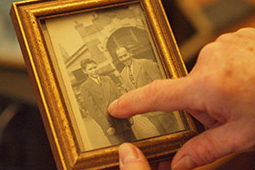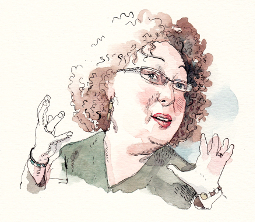The Yiddish Book Center's
Wexler Oral History Project
A growing collection of in-depth interviews with people of all ages and backgrounds, whose stories about the legacy and changing nature of Yiddish language and culture offer a rich and complex chronicle of Jewish identity.
Andy Statman's Oral History
Andy Statman, acclaimed Bluegrass mandolinist and Klezmer clarinetist, was interviewed by Christa Whitney on July 17, 2017 at the Yiddish Book Center in Amherst, Massachusetts. Andy grew up in Jackson Heights, Queens in a multi-ethnic neighborhood where everyone got along. His parents spoke Yiddish. His mother descended from cantors and there was always cantorial and klezmer music in his home. They were not very religious but sent Andy to a shtibl [small Orthodox house of prayer] to get a Jewish education. Andy remembers being carried away by the nigunim [wordless melodies]. Andy took piano lessons and at eleven became interested in bluegrass music. He used his bar mitzvah money to buy a banjo and began going to bluegrass jams in Greenwich Village. He took lessons from mandolinist David Grisman who gave him access to his huge music collection. Andy found listening and copying these artists the best way to learn but soon began to develop his own style. He considers why so many of the bluegrass musicians in New York City in that era were Jewish. At seventeen, Andy became interested in other types of music. He began to experiment and took saxophone lessons with Richard Grando, a brilliant jazz musician interested in spirituality. Prior to meeting Richard, Andy had been completely secular, but now he became interested in exploring his identity. He began a search for religious meaning in a variety of synagogues. He describes a seminal experience with a group of Lubavitcher Hasidim. At that point Andy was playing in several genres but not able to make a living as a musician. Eventually he joined David Bromberg's band and began collecting a salary. He then formed his own band and became interested in Jewish music, which few bands were playing at the time. He met Dave Tarras and the two became very close. Tarrras' music was heavily influenced by his Hasidic background. Tarras believed that the criterion for being good at playing Jewish music was to have heart, and he saw Andy as someone who would carry on, in his own way, after him. As Andy became more religious over the course of many years, and he gravitated towards Hasidic music. He began davening at the Modzitz shtibl where Ben Zion Shenker (z'l) was the cantor. Andy produced and recorded Shenker's last three records. He also became close with the Bostoner Hasidim and learned nigunim from them. He states that klezmer music is a musical offshoot of Hasidic music. Andy began experimenting with different approaches, culminating in a 1997 record titled "Between Heaven and Earth." He describes a trip to Ukraine and Poland and the hostility he experienced as a frum Jew there. Andy describes recent odd trends in Hasidic music, such as it veering into rock and pop. He laments the fact that many young klezmer musicians experiment with the music without becoming grounded in the traditional style first. Andy finds that Jewish music carries him to a more spiritual place, and he explains the connection between music and Yiddishkayt for him. Klezmer music helped Andy to express his Jewish identity, but as he became more religious, he became less interested in it. Hasidic music filled that gap for him. He is put off by the term "revivalism" and explains why he thinks secular Jews miss the point of Jewish music; they see it as party music rather than music which tries to induce a state of closeness to G-d. His advice to those who want to play Jewish music is to study the masters such as Dave Tarras, play along with their records to learn everything one can, and then start to develop one's own style.
This interview was conducted in English.


